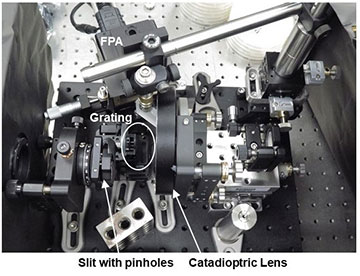
Researchers developed a compact imaging spectrometer by using a catadioptric lens and a special flat immersion reflection grating. [Credit: Ronald B. Lockwood, MIT Lincoln Laboratory]
A major breakthrough in spectroscopy occurred in the late 1970s, as optical, detection and computer technology evolved to a point where scientists could measure a spectrum for every point in an image. The first airborne imaging spectrometer, developed at the NASA Jet Propulsion Laboratory (JPL), USA, made its inaugural flight in 1982.
Today’s optical designs have overcome many of the problems that plagued early instrumentation, but reductions in size, weight and power (SWaP) remain an ongoing goal. Now, researchers at MIT Lincoln Laboratory and NASA Goddard Space Flight Center in the United States have developed a new imaging spectrometer with a significant reduction in SWaP while maintaining performance (Appl. Opt., doi: 10.1364/AO.405303).
Ten times smaller
Originally, Ronald Lockwood and his colleagues aimed to create an imaging spectrometer that could operate as part of an unmanned aerial system, meaning it had to be lighter and smaller than most of today’s devices.
“The current state of the art of imaging spectrometers is really high-performing, but there are two types of improvements possible to make them better,” said Lockwood, study author and member of technical staff at MIT Lincoln Laboratory. “You can make them optically faster by lowering the f-number, or you can make them smaller so that the SWaP penalty is not as large.”
The team focused on the latter improvement, resulting in a volume ten or more times smaller than similarly performing designs such as the Offner-Chrisp and the Dyson. A breadboard demonstration of the new design, called the Chrisp Compact VNIR/SWIR (visible, near- and shortwave infrared) Imaging Spectrometer (CCVIS), confirmed that the instrument works as desired.
Innovative components
The CCVIS employs two innovative components: a catadioptric lens and a flat dual-blaze immersion grating. The catadioptric lens—a concave meniscus lens with a reflective coating on the back—combines reflective and refractive elements into a single and more compact component. It also uses a flat grating rather than a convex or concave one, which is much easier to manufacture in addition to saving space.
As an example application, the researchers developed an imaging spectrometer design for remote sensing of aquatic ecosystems that combines multiple CCVIS modules with an optical telescope. Lockwood also suggests that the CCVIS could work well on small satellites for Earth science research and planetary missions.
“We’re trying to get funding to do, in an ideal world, an airborne demonstration and then a space demonstration,” said Lockwood. “We still have to develop a fully packaged device, so there is a lot of work to be done before the instrument is fully operational.”
